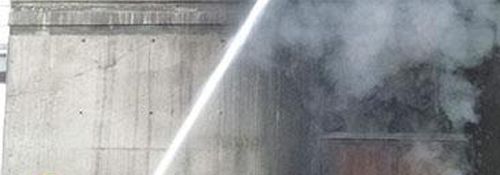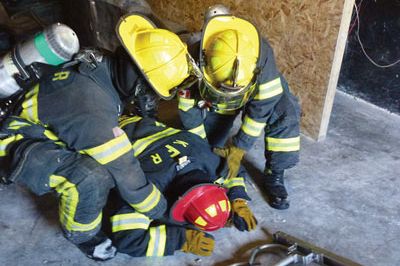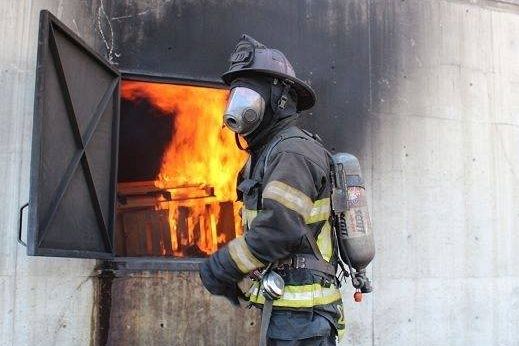
Pencilling and PPA
April 10, 2022 by Neil Campbell
When I started working in the fire service in 1995, much of a new recruit’s training was based on knowledge passed down from senior members to rookies.
We didn’t have a burn building in which to train, so live fire training wasn’t an option.
 Before beginning an exterior attack using the pencilling and PPA method, the incident commander must determine exactly where the fire is located inside the structure. In residential structure fires, this may be easy as smoke and flames may already be visible. Photos by Neil Campbell
Before beginning an exterior attack using the pencilling and PPA method, the incident commander must determine exactly where the fire is located inside the structure. In residential structure fires, this may be easy as smoke and flames may already be visible. Photos by Neil Campbell
One of the first things I was taught by my crew was to never, ever spray my hose line into the window of a structure that was on fire; if I did direct my hose line into a window, I could injure or kill anyone who may be inside by pushing the fire throughout the structure.
I was taught that we were to go inside the building, and using our hose lines, force the smoke, heat and fire out of the structure through a window or doorway. It made sense. The next fire to which I responded was a large fire in a commercial structure. I was sent to the Charlie side of the building and told to report to the captain in the alleyway. I was immediately tasked with using a pike pole to break two large windows on the back of the building. Crews operating inside the building got water on the fire, and steam and smoke started to come out the windows I had broken. It seemed pretty simple: go in the front and push the fire and smoke out the back.
We used this tactic for many years: break some windows or a door, and with smoke banking down from the ceiling – sometimes right to the floor – we crawled into the structure. The only time we would spray hose lines into the structure from the outside was when we had gone defensive – when we knew an interior attack wasn’t likely to be successful, or was just too dangerous.
Now, more than 15 years later, Kamloops Fire Rescue in British Columbia attempts positive pressure attack (PPA) at every intact residential structure fire. Instead of crawling into the structure, firefighters go in standing up. Instead of smoke-blind primary searches, now firefighters can see everything. Firefighters are able to move rapidly, find the seat of the fire faster and extinguishment happens very quickly. The threat of flashover has been all but eliminated. PPA makes the operation safer for our entry teams and for civilians who may be inside the structure. (Thanks to Kris Garcia, Reinhard Kaufmann and Ray Schelble, the creators of the PPA fire-ground tactic.)
Two years ago, I began working on an exterior fire-attack program for volunteer and minimum-manning response fire departments. This tactic incorporates pencilling the fire room from the outside of the structure with a straight stream nozzle pattern into the ceiling and PPA with a high-pressure fan – a fire-ground tactic that can be accomplished with as few as three or four firefighters.
My goal when developing the program was to disprove the old-school thinking about pushing fire with an exterior water application. After many test fires, the theory was sound: an external water application incorporating PPA did not push fire, smoke, or super-heated gases throughout the structure. In fact, quite the opposite was true: fire knock down and extinguishment was accomplished with no transference of heat, smoke, or fire into other rooms in the structure.
In December 2010, Steve Kerber, a fire research engineer with Underwriters Laboratories, wrote a paper called Impact of Ventilation on Fire Behavior in Legacy and Contemporary Residential Construction. The 400-page report examines fire-service ventilation practices and the impact of changes in modern house geometries. Extensive research was conducted on the air flow paths inside a structure fire and the effect of ventilation on these flow paths.
“There were no temperature spikes in any of the rooms, especially the rooms adjacent to the fire room when water was applied from the outside,” the report says.
“It appears that in most cases the fire was slowed down by the water application and that external water application had no negative impacts to occupant survivability. While the fog stream “pushed” steam along the flow path there was no fire pushed.”
Further, Kerber says, “If you add air to the fire and don’t apply water in the appropriate time frame, the fire gets larger and safety decreases. Co-ordination of fire attack crews is essential for a positive outcome in today’s fire environment.”
What does this mean? Simply put, for the safety of firefighters and people trapped in a burning structure, it is essential that the structure be ventilated to release the super-heated gases and smoke. Ventilation must immediately be followed by a well co-ordinated attack with hose lines from either the inside or outside of the structure. The quicker ventilation occurs, and water is put on the fire, the quicker problems start to disappear. Delays getting water on the fire after the building has been ventilated will result in the growth of the fire, sometimes extremely rapid growth.
The steps for an exterior fire attack can be accomplished quickly, even with a four-person crew. The incident commander (IC) must determine where the fire is inside the structure. The IC can do this by doing a 360-degree size-up. This can be done quickly for residential structures. Sometimes finding the fire is easy as the fire may have breached a window and the smoke and flames are already showing. If the fire hasn’t broken any windows, a crew member must be tasked with this job. It is important to make the vent opening (or openings, if it is a small window) as close to the seat of the fire as possible. This will help to reduce temperatures, smoke and fire gases inside the structure and help to prevent fire spread to unburned areas. The firefighter tasked with breaching the window will also be the exterior hose line operator, or nozzle man.
While hose lines are being stretched, another crew member must be tasked with positioning and starting the positive pressure fan. The fan should be positioned in front of an opening in the structure, preferably a doorway. The moment the window is breached, the door to the structure is opened and the fan is positioned 1.2 to 1.8 metres (four to six feet) from the opening at a 15-degree upward angle. The fan is then turned-on full throttle.
 The pencilling technique involves pushing a straight stream of water into the ceiling of the room in which the fire is located. This method of water dispersal results in a rain-down effect inside the room, producing massive heat absorption capabilities.
The pencilling technique involves pushing a straight stream of water into the ceiling of the room in which the fire is located. This method of water dispersal results in a rain-down effect inside the room, producing massive heat absorption capabilities.
The effect of the forced ventilation should be immediate. An airflow pattern from the doorway through the structure and out the breached window will now be established. Smoke and heat will be forced out of the structure and replaced with cool, fresh air. Once the window is breached, the goal is to get water pencilling into the ceiling as quickly as possible. Pencilling is a straight or solid stream introduced through an opening into a room or area of origin for a limited amount of time with the objective of confining the fire.
The duration for the initial application of water is a judgment call but the pencilling must be meaningful. Just two or three short bursts of water will not achieve positive results; pencilling should darken down the fire, and if luck is on your side, extinguish it.
I was discussing pencilling with Reo Jerome, a captain and acting battalion chief with the City of Surrey Fire Service; we both see value in the pencilling tactic for firefighter safety and fire control. Reo reminded me of some basics on fire flow.
“When selecting the initial hose line and amount of water required, a good rule of thumb to use is the National Fire Academy Fire Flow Formula, which is the square feet of involvement divided by three. This formula will help you choose the gallons per minute (gpm) required to knock down a given sized room-and-contents fire. There is nothing worse than taking an inch-and-a-half to a two-and-a-half fire; it’s kind of like bringing a knife to a gun fight,” he said.
“I am not suggesting that you pull out a calculator at 3 a.m. and start punching numbers in. Keep it simple and do it beforehand.”
Firefighters can determine room size during the 360-degree size-up based on the location of the room and size of the windows, Jerome said.
Here are two examples:
Venting fire out of a second floor kid’s bedroom window:
- 12 feet x 12 feet = 144 square feet (round up to 150)
- 150 divided by 3 = 50 gpm required
A one-and-one-half-inch hose line with 95 gpm is plenty for this fire
Venting fire out of a first-floor living room or third-floor studio apartment unit:
A two-and-one-half-inch hose line at 250 gpm is plenty for this fire, or an inch-and-three-quarter hose line at 200 gpm, or even two one-and-one-half-inch hoselines at 95 gpm each
- 20 feet x 30 feet = 600 square feet
- 600 divided by 3 = 200 gpm required
 The airflow pattern from the doorway of the structure, where the PPA fan is located, through the structure and out the breached window will force smoke and heat from the structure, replacing it with cool, fresh air, while the pencilling works to darken, and hopefully extinguish, the blaze.
The airflow pattern from the doorway of the structure, where the PPA fan is located, through the structure and out the breached window will force smoke and heat from the structure, replacing it with cool, fresh air, while the pencilling works to darken, and hopefully extinguish, the blaze.
The flow of water onto the ceiling results in a rain-down effect inside the room. When water is dispersed this way, it has massive heat absorption capabilities. Continue with this exterior attack even if an airflow pattern from the doorway to the breached window cannot be established. The lack of airflow will likely be due to a closed door in between the outside doorway and the breached window. Continue with the positive pressure as the fan will pressurize the structure right up to the closed door. This pressurization will prevent the smoke, heat, and fire gases from getting into the rest of the structure.
We all know that electricity always tries to find its way to ground and will always find the path of least resistance to do so. Smoke and super-heated fire gases are the same, except that they are not trying to get to ground, they are trying to get to an area of low atmospheric pressure, or outside (unless that side of the structure is wind driven, of course). When a fire starts inside a structure, it creates pressure. The hotter and larger the fire gets; the more pressure is created. Break a window and the pressure will be released. With that pressure release will come super-heated fire gases, smoke and – quite likely – fire.
The nozzle man should be prepared to do lapping protection – spraying water around and above the breached window to prevent the fire from impinging the outside of the structure. If a transitional attack is being deployed, it is crucial that the IC notify the nozzle man on the outside when a team is about to transition to the inside to ensure that opposing hose streams do not impact the safety of the inside team. Vinyl or wood siding on homes is extremely susceptible to this type of fire spread. Wetting down the outside of the home near a breached window can prevent fire spread.
The window has been breached by a crew member or by the fire, the side of the building around and above the breached window has been sprayed with water, and the fan is running at full throttle. Pencilling has been initiated with a straight-stream nozzle pattern to the ceiling inside the room on fire, and the fire appears to be almost out. Now what? Even resource-challenged or defensive-only fire departments must go interior eventually to search for civilians and complete overhaul – but only if the building is structurally sound. Once overhaul is complete and no further fire spread is discovered, fire-ground operations are complete.
Pencilling and PPA can be used together extremely successfully but require strong leadership on the fire ground. These tactics must be employed with precision, crew co-ordination and communication.
Neil Campbell is a 26-year retired fire-service veteran and is the president of Provincial Fire and Safety Training Ltd. Neil, along with the members of Provincial Fire and Safety, continues to work in the emergency fire service field as an instructor and training provider.
Insights
Keep up to date with training tactics and strategies for emergency responder safety and training programs. Industry leaders in safety and training programs share their insights on past and current trends and topics here.



